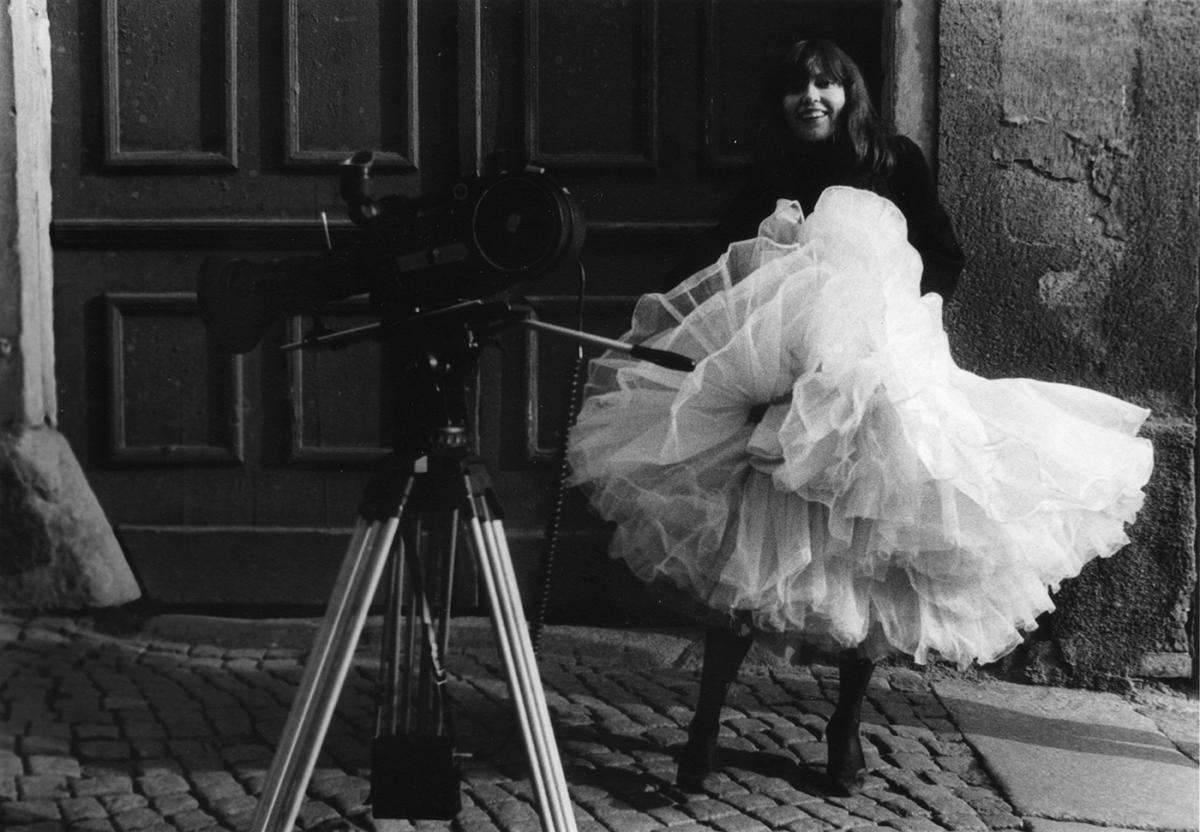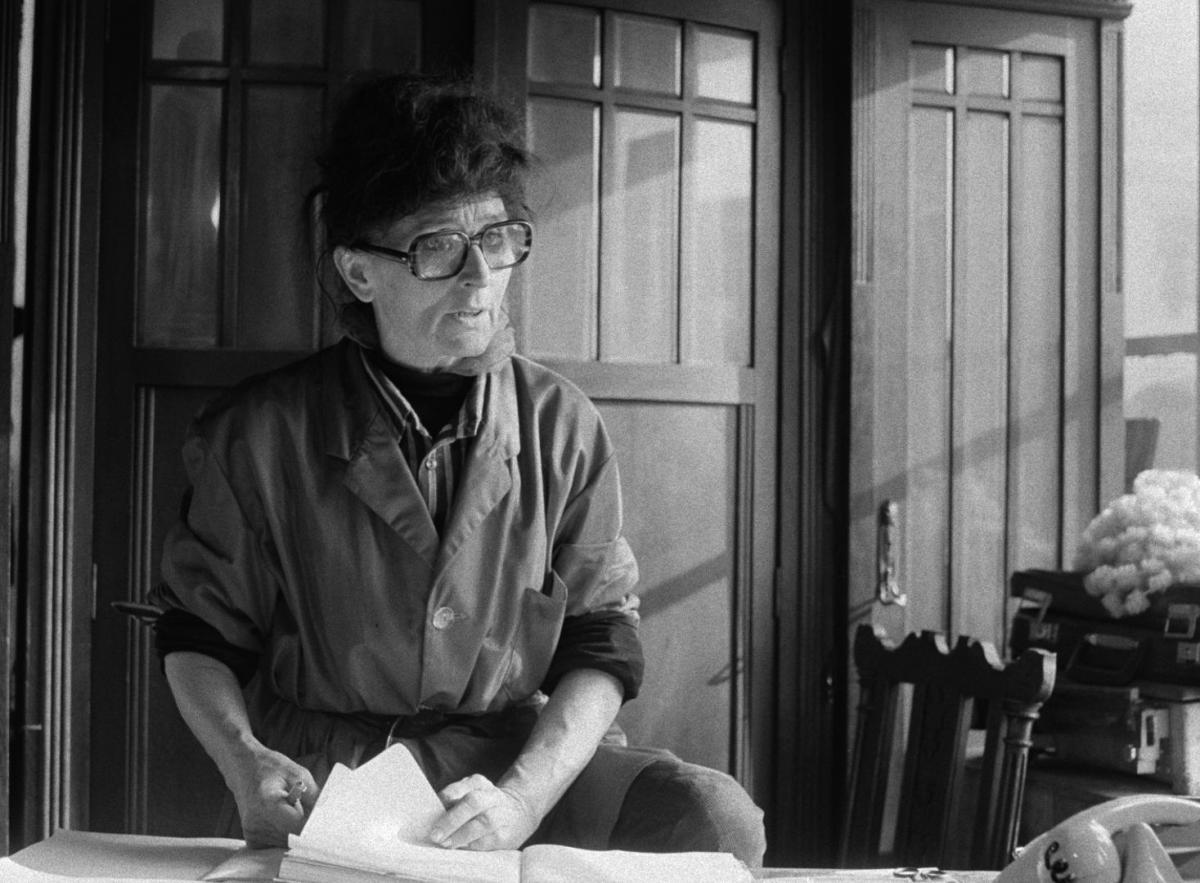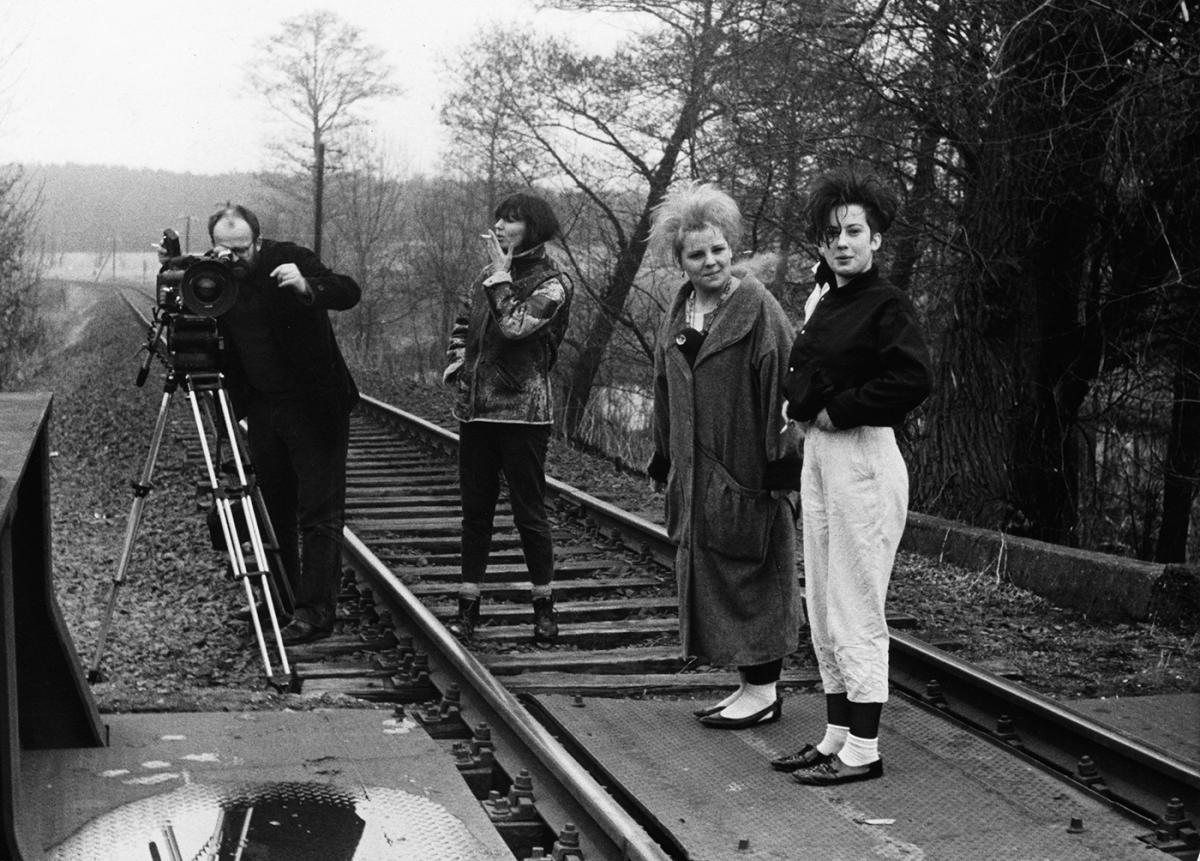“Film is always the present”
A Conversation with Helke Misselwitz
Helke Misselwitz (1947) distinguished herself as a documenter of lives in disarray and utmost ordinariness with great warmth in the years around German reunification. What is vividly clear in her first feature-length documentary, Winter Adé (1988), which sees the filmmaker travel the country by train one year before the fall of the Berlin Wall, is the interest in women’s societal and social roles in particular. Misselwitz worked a range of jobs, in carpentry and as a television host, before studying directing at the Academy for Film and Television in Potsdam-Babelsberg between the years 1978 and 1982. She later began making short pieces for DEFA (Deutsche Film-Aktiengesellschaft) Studio for Documentary Film, the state-owned East German film studio, after being refused entry to the Feature Film Studio. These pathways were rigid, and Misselwitz continued to work freelance while raising a daughter.
Her films depict sceptical punks, furnace workers, nude photographers, dance school owners and teenage runaways. It is a clear-eyed cinema that not only looks into but is invited into rooms where there is both celebration and discontent, and what lingers after the films’ viewing is the small details that come to stand as a larger chronicle for an era.

Elizabeth Dexter: Could we begin please with a nuts-and-bolts question about how you came to this work in the years you did?
Helke Misselwitz: I worked my way up. I was an assistant director in youth television. Journalistic programmes and entertainment programmes for young people were produced there.
I also took over some of the directing of films we made. Of course, the work was done professionally. There were editors there. Someone directed, in this case me, with a sound engineer and a cameraman. We worked in such teams. Later, when I studied directing at the film academy in Babelsberg, everyone in the team did a bit of everything at the beginning.
After film school, I always worked with a team. With documentaries, of course, small teams. The usual: the director, the cameraman – there were hardly any female cinematographers in the film business at the time, maybe one or two, someone did the sound, someone did the production management and drove the car at the same time. There were always four or five people on the road.
Were there any early artistic influences, certain kinds of cinema you felt affinities with at that time, or earlier on?
It was always the interest in other people’s lives. More than other films or directors.
I think every life is worth telling. It’s just that not all people can tell interesting stories about it. One becomes a kind of helper. You help to describe the lives of others.
How then did you come across and into the lives that you began filming? Were these political subjects or narratives sought out deliberately?
It’s always different. Different in every one of these small films that are shown here [in Tui], the short films that I was able to make myself. That was one reason to go to the DEFA Documentary Film Studio in the first place. I didn't go back to television after graduating. I would have had to go back there, that was determined. So, I rejected that job, which is not easy after graduation, to survive. I then did other jobs. I worked as a temp in a gallery that mainly exhibited photography. I helped hang photos, made sure no one stole anything during exhibitions, or washed dishes in a restaurant to earn a living.
But I didn’t have to do that for so long. In the DEFA Documentary Film Studio there was a group called KINOBOX. They made a cinema magazine, always with short contributions, three or four short contributions. The director was one of the few directors in this studio who was really interested in film and knew film. And he simply brought in young people like me who he thought were interesting and gave them assignments.
He gave us assignments with a topic, and I turned that assignment into my assignment. I made it personal. For example, something on Karl Marx [the film Marx-Familie, 1983–88], on Karl Marx’s seven bad years. That was quite exciting for me, something I also knew nothing about. To find out what happened during those seven years. Then I just asked myself: How do I tell this? How can I tell it? So that it is interesting for others. That it has something to do with me and life here. And in some way that it is quite normal too, and not something heroic. This heroic veneration of Marx, Engels, and Lenin, seeing them everywhere on banners... To take them off the pedestal and show them as normal people, who lived a life.

In this film and in your broader work, there is an abundance of printed photographs, manifestos on paper, pages, documents, as small pieces of evidence, to guide or spark recollection perhaps. Things that can be both monumental and not in this same way. I would like to speak to you about all this ephemera, and about what role it is playing.
I would have to go back to my childhood. I was sick a lot. I enjoyed that time: I could go to the big bookcase, and I’d pull out the art volumes, a stack like that. And the photo albums of my family. Every family member had a photo album, back to the grandparents, great-grandparents. And on the sofa, where I could lie, I put them next to me and looked at the family photos, but also at the art books. I didn’t distinguish between them.
Everything happened behind tissue paper, there was always tissue paper separating the images. And I was quite surprised every time what was hidden behind it. I looked at it again and again. This normal life, these snapshots, and the art, and in art the special vision, the light for example. Rembrandt is the painter who explores what light does to a portrait. I didn’t reflect on that as a little child, but it was there, and it fascinated me.
That stimulated my imagination so much. Photographs are memories, they evoke memories. And I wondered: what kind of life is behind them? And of course, with Rembrandt’s portraits you can ask that too: what kind of life did that person live? Film is always the present.
When I use photographs, when I use memory, when I confront the person with it, with the photo from before; that is also a way of describing the transience of life: I have this photo from sixty years ago, sixty years have now passed in between, what happened there? Now the person is like this. A description of transience there too.
The television sets are also striking in a way, as leitmotivs that shuttle in time and history through news images, though they often appear as quite strange, little ambivalent items. I’m curious whether you were nodding to your work’s production being tied to the medium, or to how much or how little it mattered to the lives you were interested in.
I always try to make a reference to the time in which I worked: through a newspaper stuck in a coat somewhere, so that you know it was 1989. Television pictures are also very good for this. What is the official image that is conveyed? And that in contrast to the image I'm looking for, the image I imagined.
In Winter Adé, those television images: That was a shop where television sets are sold, at Alexanderplatz, which was closed at seven o’clock, when it got dark. But I wanted this official portrait of Women’s Day – which was already a holiday in the GDR at that time.
I shot those images two years before we filmed on the platform in Altenburg with Hilly, the first woman that speaks for so long on the train, we’re standing in the station in Altenburg and she’s talking about how she was decorated, how she got her medal and asked herself: Is this a kingdom? What is this? When everybody had to stand up, when the high gentlemen came in, the officials, and they had to stand up and pay respect to them – it wasn’t the other way around. And that’s exactly how it happens in the film, in these television pictures, on all these monitors. It’s portrayed in exactly the same way. It’s also proof of what she’s saying.
We are also compelled of course to look at labour, everyone introduces their job, or their training pathway, as well as us seeing them perform them. This draws us to your profession in filmmaking. Where do you see the filmmaker as situated?
It always depends on who the contracting authority is. Who gives the money? You are rarely independent if you don’t make yourself independent. But you can choose. In fact, it has become more difficult. The ideologization seems to have disappeared after the end of the GDR. Now money decides. That’s also a kind of ideology. Many institutions granting funding demand that the film will be commercially well exploited, and you have to lie. You have to say: Yes, it will be very well received at the cinema. A lot of people will see it. So that you can get the money at all. And that is a lie. You know, documentaries don’t get millions of people to the cinema. But you have to lie, you have to employ tactics in order to get any money at all.
Of course, you can say you can make a film with your mobile phone, without money. But the way I learned and experienced it – it’s important for me to make a film with others, with others who are all professional, professionals for camera and sound. I don’t want to take away their work. Of course, I could somehow do it all alone, but it’s a different concentration. When you do something together with others, there are other ideas and inspirations that come from working with others. It’s more communicative, and it just gets better when you make a film together with others.

This communal aspect extends beyond and then into the frame, and you make yourself visible as a part of it…
It’s a question of fairness. I ask people very intimate things, and they are visible on camera, and I am not visible. With Winter Adé, it was very important for me to be visible. I also start off very personally, without being seen. You only see my legs, I tell you about my birth, in front of the railway crossing. Then you see me walking through the station and you hear a woman’s voice.
That also has something to do with the cameraman. The first time I didn’t know that he was filming me at the station, I was also visible when I was talking to the woman. He stood behind me and then said that it was important that I was visible at that moment.
And then I have this dance scene with the man celebrating his diamond wedding anniversary. I myself said that I would dance with him and have the conversation, because I thought that was appropriate. They’re all celebrating and there’s dancing, so why should I withdraw into another room?
Was the camera apparatus ever something you wanted to consciously challenge in some way?
There is a cameraman, in every film there is a cameraman. I share his gaze and he shares my gaze. I sit close or stand close to the camera. For him, the camera is like an organ. I then talk to people, or we watch something together. But it’s finally he who decides on how the light falls or which framing to use.
And then the question was, do I disempower the camera when I enter the frame?
This way I am a player. We are playing together. It’s not just the fiction-film [she uses the term Spielfilm which is hard to translate. Spiel translates to play. A Spielfilm is therefore a play-film]. You also become a player somewhere. One would also like to express oneself. I choose people for certain reasons, and then they also become players. We are actually on the same level.
And, and this is enormously important: I trust the cameraman at the moment when I remove myself from my position. That has something to do with trust.

This conversation occurred on the occasion of a retrospective of her films that encompassed three short and three longer works, at the documentary film festival Play-Doc in Tui, Galicia. A selection of nine of her films are currently available to stream through the Doc Alliance platform in Helke Misselwitz: Journeys Through a Country That No Longer Exists.
Thanks go to Jorge Álvarez Romero and to Martin Klein for their translations from German into English.
Image (1), Set photo of Winter Adé (Helke Misselwitz, 1988). ©Thomas_Plenert
Image (2) from Aktfotografie, z.B. Gundula Schulze (Helke Misselwitz, 1983)
Image (3) from Wer fürchtet sich vorm schwarzen Mann (Helke Misselwitz, 1989)
Image (4), Set photo of Winter Adé (Helke Misselwitz, 1988) ©Michael_Loewenberg

